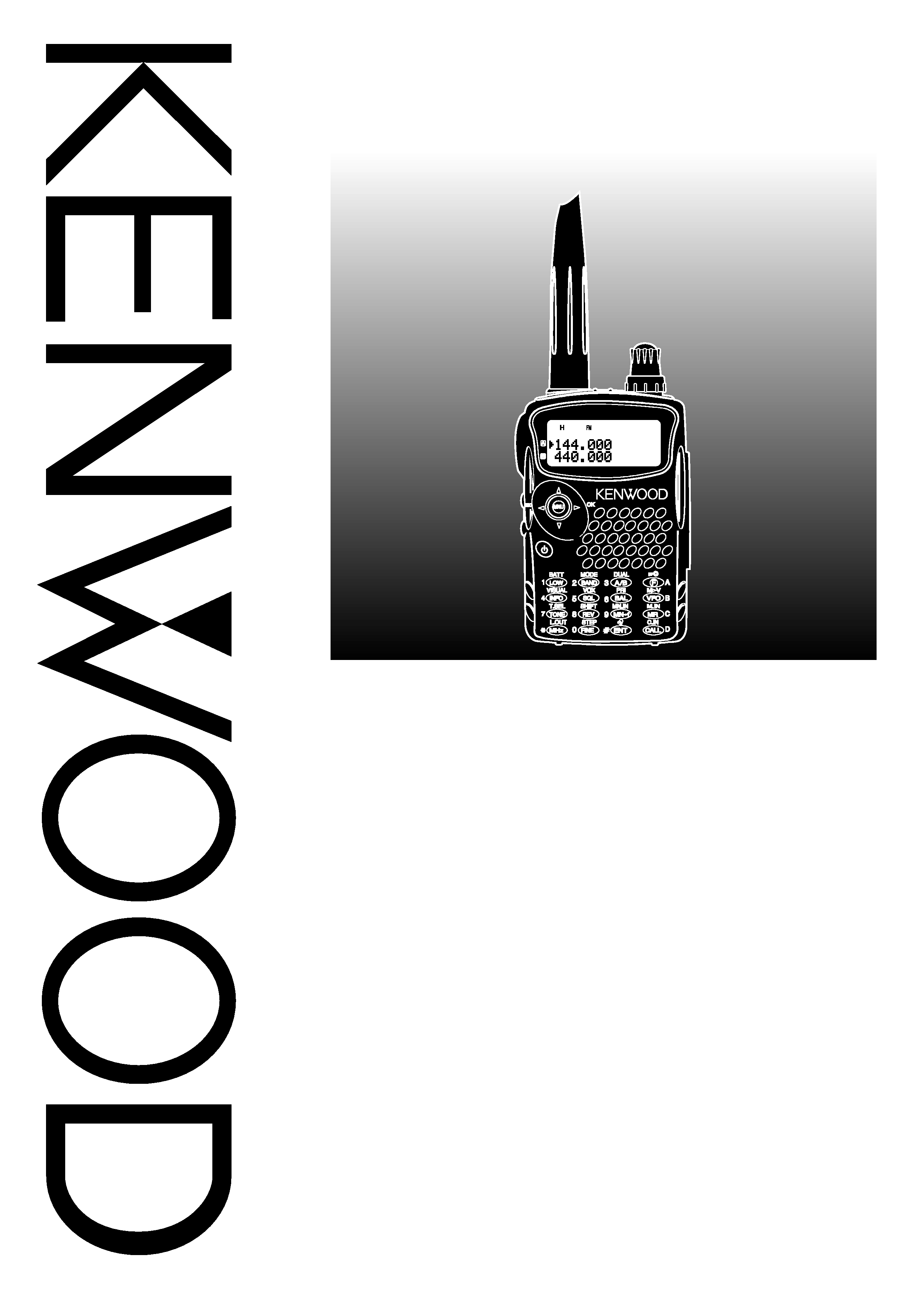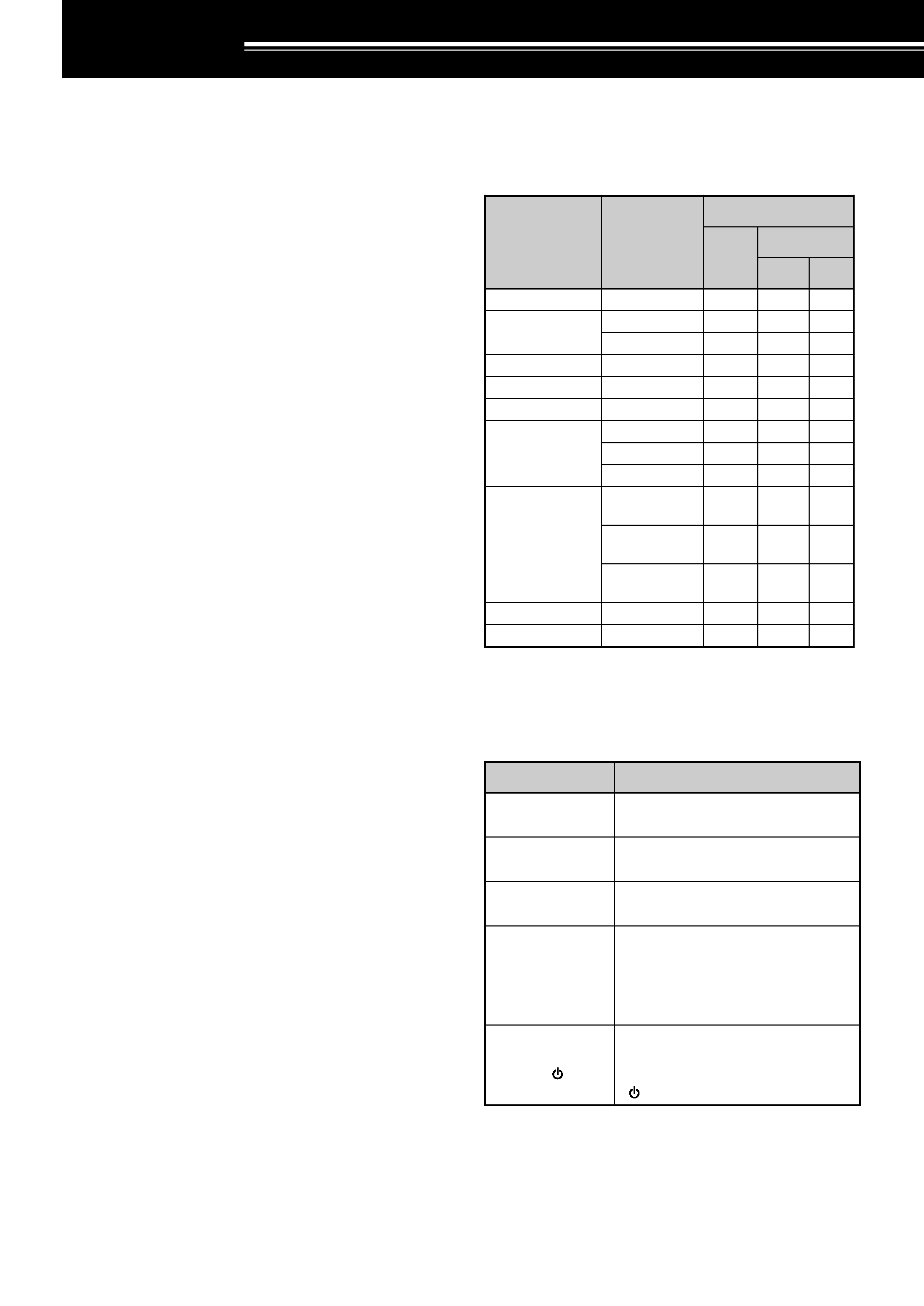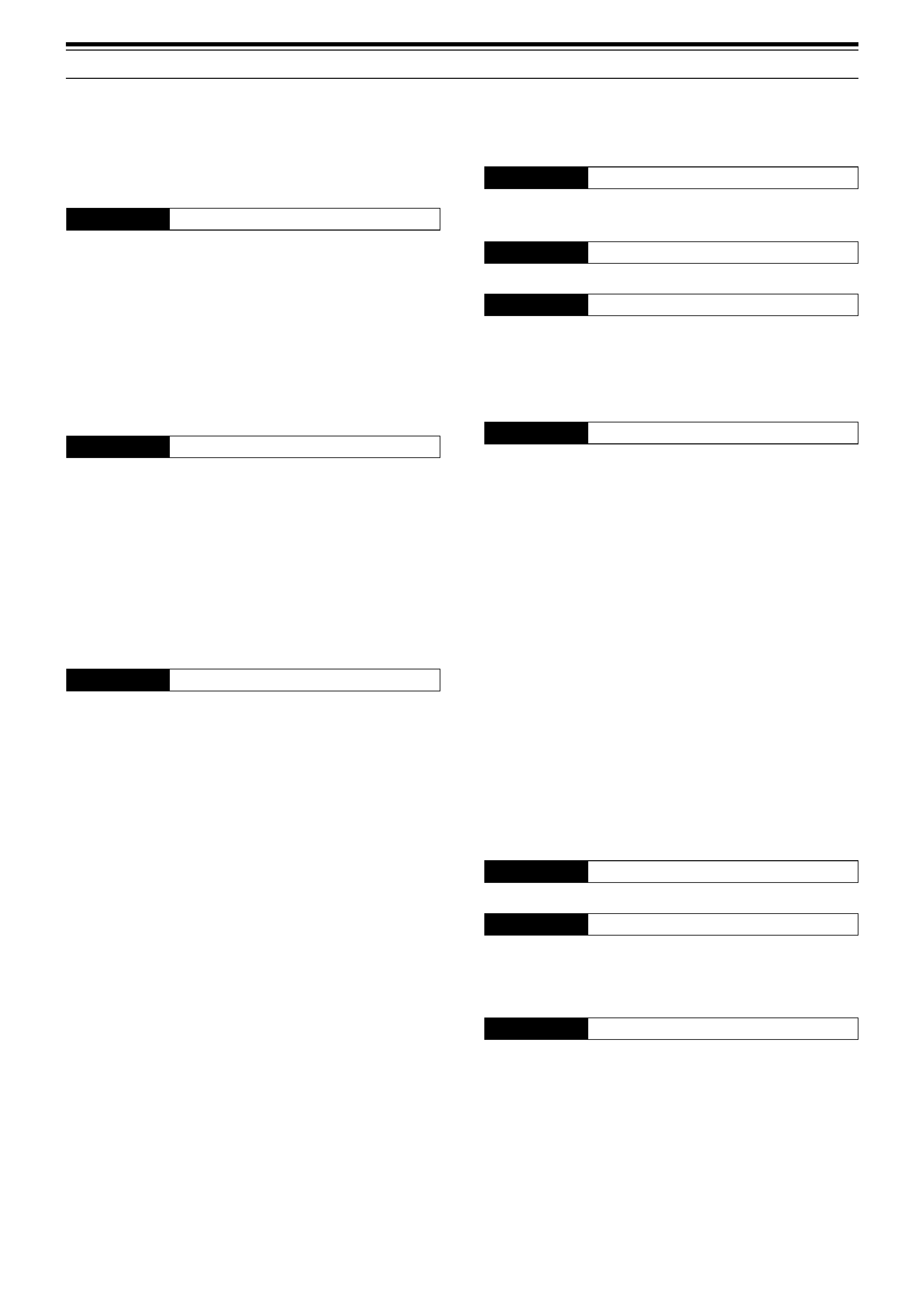
© B62-1441-00 (K,E,T)
09 08 07 06 05 04 03 02 01 00
144/ 220/ 440 MHz FM TRIBANDER
TH-F6A
144/ 430 MHz FM DUAL BANDER
TH-F7E
INSTRUCTION MANUAL
KENWOOD CORPORATION
FM TRIBANDER TH-F6

MODELS COVERED BY THIS MANUAL
The models listed below are covered by this manual.
TH-F6A:
144/ 220/ 440 MHz FM Tri-band
Portable Transceiver
TH-F7E:
144/ 430 MHz FM Dual-band
Portable Transceiver
MARKET CODES
K-type:
The Americas
E-type:
Europe/ General
T-type:
The United Kingdom
The market code is shown on the carton box.
Refer to the specifications {pages 53, 54} for the
information on available operating frequencies within
each model.
NOTICE TO THE USER
One or more of the following statements may be
applicable for this equipment.
FCC WARNING
This equipment generates or uses radio frequency energy.
Changes or modifications to this equipment may cause harmful
interference unless the modifications are expressly approved in
the instruction manual. The user could lose the authority to
operate this equipment if an unauthorized change or
modification is made.
INFORMATION TO THE DIGITAL DEVICE USER REQUIRED
BY THE FCC
This equipment has been tested and found to comply with the
limits for a Class B digital device, pursuant to Part 15 of the
FCC Rules. These limits are designed to provide reasonable
protection against harmful interference in a residential
installation.
This equipment generates, uses and can generate radio
frequency energy and, if not installed and used in accordance
with the instructions, may cause harmful interference to radio
communications. However, there is no guarantee that the
interference will not occur in a particular installation. If this
equipment does cause harmful interference to radio or
television reception, which can be determined by turning the
equipment off and on, the user is encouraged to try to correct
the interference by one or more of the following measures:
·
Reorient or relocate the receiving antenna.
·
Increase the separation between the equipment and receiver.
·
Connect the equipment to an outlet on a circuit different from
that to which the receiver is connected.
·
Consult the dealer for technical assistance.
PRECAUTIONS
Please observe the following precautions to prevent
fire, personal injury, or transceiver damage:
·
Do not transmit with high output power for
extended periods. The transceiver may overheat.
·
Do not modify this transceiver unless instructed by
this manual or by KENWOOD documentation.
·
When using a regulated power supply, connect the
specified DC cable (option) to the DC IN jack on
the transceiver. The supply voltage must be
between 12 V and 16 V to prevent damaging the
transceiver.
·
When connecting the transceiver to a cigarette
lighter socket in a vehicle, use the specified
cigarette lighter cable (option).
·
Do not expose the transceiver to long periods of
direct sunlight nor place the transceiver close to
heating appliances.
·
Do not place the transceiver in excessively dusty
areas, humid areas, wet areas, nor on unstable
surfaces.
·
If an abnormal odor or smoke is detected coming
from the transceiver, turn OFF the power
immediately and remove the battery case or the
battery pack from the transceiver. Contact your
authorized KENWOOD dealer, customer service,
or service station.

i
THANK YOU
THANK YOU
Thank you for choosing this KENWOOD TH-F6A/
TH-F7E transceiver. It has been developed by a
team of engineers determined to continue the
tradition of excellence and innovation in KENWOOD
transceivers.
First, don't let the size fool you. This small FM
portable transceiver features 2 m, 1.25 m (TH-F6A
only), and 70 cm amateur radio band operation plus
another all-mode 100 kHz to 1.3 GHz receiver (SSB
and CW are up to 470 MHz). In the meantime, as
you learn how to use this transceiver, you will also
find that KENWOOD is pursuing "user friendliness".
For example, each time you change the Menu No. in
Menu mode, you will see a text message on the
display that lets you know what you are configuring.
Though user friendly, this transceiver is technically
sophisticated and some features may be new to you.
Consider this manual to be a personal tutorial from
the designers. Allow the manual to guide you through
the learning process now, then act as a reference in
the coming years.
FEATURES
·
Ultra compact design
·
2 m, 1.25 m (TH-F6A only), and 70 cm amateur
radio band FM transceiver operation
·
A separate wide band, all-mode receiver, built-in
·
Dual-frequency receive within the same amateur
radio bands
·
400 memory channels plus 34 special function
memory channels (35 channels for TH-F6A)
·
Long operation period with a Li-ion battery pack
·
High output power (up to 5 W operation)
·
Easy to control and select various functions with
Multi-scroll key
·
9600 bps Packet-ready data (Speaker/ Mic.) jack
·
Built-in VOX function
·
Meets MIL-STD 810C/ D/ E, Rain, Humidity,
Vibration, and Shock
SUPPLIED ACCESSORIES
After carefully unpacking the transceiver, identify the
items listed in the table below. We recommend you
keep the box and packing material in case you need
to repack the transceiver in the future.
y
r
o
s
s
e
c
c
A
r
e
b
m
u
N
t
r
a
P
y
t
i
t
n
a
u
Q
A
6
F
-
H
T
E
7
F
-
H
T
)
K
(
)
E
(
)
T
(
k
o
o
h
t
l
e
BX
X
-
3
2
6
0
-
9
2
J1
1
1
a
n
n
e
t
n
A
X
X
-
1
8
7
0
-
0
9
T1
X
X
-
9
8
7
0
-
0
9
T
1
1
p
a
r
t
SX
X
-
2
4
3
0
-
9
6
J1
1
1
r
e
t
li
F
e
n
i
LX
X
-
7
1
4
1
-
9
7
L
1
1
y
r
e
t
t
a
b
n
o
i
-
i
LX
X
-
9
7
9
0
-
9
0
W1
1
1
r
e
g
r
a
h
C
X
X
-
7
2
9
0
-
8
0
W1
X
X
-
8
2
9
0
-
8
0
W
1
X
X
-
9
2
9
0
-
8
0
W
1
n
o
i
t
c
u
r
t
s
n
I
l
a
u
n
a
M
X
X
-
1
4
4
1
-
2
6
B
)
S
/
E
(
11
1
X
X
-
2
4
4
1
-
2
6
B
)
I
/
F
(
1
X
X
-
3
4
4
1
-
2
6
B
)
G
/
D
(
1
e
c
i
t
o
N
E
T
T
&
RX
X
-
7
6
2
2
-
9
5
B
1
1
d
r
a
c
y
t
n
a
r
r
a
W--
1
1
1
WRITING CONVENTIONS FOLLOWED
The writing conventions described below have
been followed to simplify instructions and avoid
unnecessary repetition.
n
o
i
t
c
u
r
t
s
n
I
o
D
o
t
t
a
h
W
s
s
e
r
P
]
Y
E
K
[
.e
s
a
e
l
e
r
d
n
a
s
s
e
r
P
Y
E
K
.
s
s
e
r
P
]
1
Y
E
K
[
,
]
2
Y
E
K
[
.
s
s
e
r
P
1
Y
E
K
e
s
a
e
l
e
r
,
y
li
r
a
t
n
e
m
o
m
1
Y
E
K
s
s
e
r
p
n
e
h
t
,
2
Y
E
K
.
s
s
e
r
P
]
Y
E
K
[)
s
1
(
.
d
l
o
h
d
n
a
s
s
e
r
P
Y
E
K
a
r
o
f
n
w
o
d
.
d
n
o
c
e
s
s
s
e
r
P
]
2
Y
E
K
[
+
]
1
Y
E
K
[
.
d
l
o
h
d
n
a
s
s
e
r
P
1
Y
E
K
n
e
h
t
,
n
w
o
d
s
s
e
r
p
2
Y
E
K
e
r
o
m
e
r
a
e
r
e
h
t
f
I
.
d
l
o
h
d
n
a
s
s
e
r
p
,
s
y
e
k
o
w
t
n
a
h
t
e
h
t
li
t
n
u
n
r
u
t
n
i
y
e
k
h
c
a
e
n
w
o
d
.
d
e
s
s
e
r
p
n
e
e
b
s
a
h
y
e
k
l
a
n
i
f
s
s
e
r
P
]
[
+
]
Y
E
K
[
.
s
s
e
r
p
,
F
F
O
r
e
v
i
e
c
s
n
a
r
t
e
h
t
h
t
i
W
d
l
o
h
d
n
a
Y
E
K
N
O
h
c
t
i
w
s
n
e
h
t
,
g
n
i
s
s
e
r
p
y
b
r
e
w
o
p
r
e
v
i
e
c
s
n
a
r
t
e
h
t
]
[
.
)
R
E
W
O
P
(
Since the amateur radio bands are slightly different
from country to country, the following meter band
descriptions are used in this manual.
·
2 m band
: 144 ~ 148 MHz or 144 ~ 146 MHz
·
1.25 m band : 222 ~ 225 MHz
·
70 cm band : 420 ~ 450 MHz or 430 ~ 440 MHz

ii
CONTENTS
TONE FREQ. ID SCAN ......................................... 14
CHAPTER 6
MEMORY CHANNELS
SIMPLEX & REPEATER OR ODD-SPLIT MEMORY
CHANNEL? ........................................................... 15
STORING SIMPLEX FREQUENCIES OR
STANDARD REPEATER FREQUENCIES ......... 15
STORING ODD-SPLIT REPEATER
FREQUENCIES ................................................. 15
RECALLING A MEMORY CHANNEL ................. 16
Using the Tuning Control or /
keys ........... 16
Using a Numeric Keypad .............................. 16
CLEARING A MEMORY CHANNEL ................... 16
MEMORY RECALL MODE ................................ 16
NAMING A MEMORY CHANNEL ........................... 17
MEMORY CHANNEL GROUPS ............................ 18
RECALLING A MEMORY CHANNEL USING
MEMORY GROUP FUNCTION ......................... 18
ERASING MEMORY CHANNELS USING
MEMORY GROUP DELETE FUNCTION ........... 18
MEMORY CHANNEL TRANSFER ......................... 18
MEMORY \ VFO TRANSFER .......................... 18
CHANNEL \ CHANNEL TRANSFER ............... 18
CALL CHANNEL .................................................... 19
RECALLING THE CALL CHANNEL ................... 19
REPROGRAMMING THE CALL CHANNEL ...... 19
INFORMATION CHANNELS .................................. 20
RECALLING AN INFORMATION CHANNEL ..... 20
REPROGRAMMING THE INFORMATION
CHANNEL ......................................................... 20
CHANNEL DISPLAY .............................................. 21
CHAPTER 7
SCAN
NORMAL SCAN .................................................... 22
BAND SCAN ..................................................... 22
PROGRAM SCAN ............................................. 23
Storing Program Scan Frequency Range ...... 23
Performing the Program Scan ....................... 23
MHz SCAN ........................................................ 23
MEMORY SCAN .................................................... 24
ALL-CHANNEL SCAN ....................................... 24
GROUP SCAN .................................................. 24
Memory Group Link ...................................... 24
CALL SCAN ........................................................... 25
PRIORITY SCAN .................................................... 25
PROGRAMMING PRIORITY CHANNELS ......... 25
USING PRIORITY SCAN ................................... 25
INFORMATION CHANNEL SCAN ........................... 26
VISUAL SCAN ........................................................ 26
USING VISUAL SCAN (VFO) ............................ 26
USING VISUAL SCAN
(MEMORY CHANNEL) ...................................... 27
MEMORY CHANNEL LOCKOUT ........................... 27
SCAN RESUME METHOD .................................... 27
CHAPTER 8
SELECTIVE CALL
CTCSS and DCS ................................................... 28
CTCSS .................................................................. 28
USING CTCSS .................................................. 28
MODELS COVERED BY THIS MANUAL
MARKET CODES
NOTICE TO USER
PRECAUTIONS
THANK YOU ............................................................. i
FEATURES ............................................................... i
SUPPLIED ACCESSORIES ..................................... i
WRITING CONVENTIONS FOLLOWED .................. i
CONTENTS ............................................................. ii
CHAPTER 1
PREPARATION
INSTALLING THE Li-ion BATTERY PACK ............... 1
INSTALLING ALKALINE BATTERIES ...................... 1
INSTALLING THE ANTENNA .................................. 1
ATTACHING THE HAND STRAP ............................. 1
INSTALLING THE BELT CLIP .................................. 1
CHARGING THE Li-ion BATTERY PACK ................. 2
CONNECTING TO A CIGARETTE LIGHTER
SOCKET .................................................................. 2
CONNECTING TO A REGULATED
POWER SUPPLY .................................................... 2
CHAPTER 2
YOUR FIRST QSO
FIRST QSO ............................................................. 3
CHAPTER 3
GETTING ACQUAINTED
KEYS AND CONTROLS .......................................... 4
DISPLAY ................................................................. 5
BASIC OPERATION
SWITCHING POWER ON/ OFF .......................... 6
ADJUSTING VOLUME ........................................ 6
ADJUSTING SQUELCH ...................................... 6
SELECTING A BAND .......................................... 6
MULTI-SCROLL KEY ........................................... 6
TRANSMITTING .................................................. 7
Selecting Output Power .................................. 7
SELECTING A FREQUENCY .............................. 7
VFO mode ...................................................... 7
MHz mode ...................................................... 7
Direct Frequency Entry ................................... 7
CHAPTER 4
MENU SETUP
WHAT IS A MENU? .................................................. 9
MENU ACCESS ...................................................... 9
SELECTING A MENU LANGUAGE ......................... 9
MENU FUNCTION LIST .......................................... 9
ALPHABETICAL FUNCTION LIST ......................... 11
CHAPTER 5
OPERATING THROUGH REPEATERS
OFFSET PROGRAMMING FLOW ......................... 12
PROGRAMMING OFFSET ................................ 12
Selecting Offset Direction .............................. 12
Selecting Offset Frequency ........................... 12
Activating Tone Function ............................... 13
Selecting a Tone Frequency .......................... 13
AUTOMATIC REPEATER OFFSET ....................... 13
REVERSE FUNCTION .......................................... 14
AUTOMATIC SIMPLEX CHECK (ASC) .................. 14

iii
VOX ....................................................................... 41
VOX GAIN ......................................................... 41
VOX DELAY TIME ............................................. 41
VOX ON BUSY .................................................. 42
CHAPTER 12
WIRELESS REMOTE CONTROL
PREPARATION ..................................................... 43
CONTROL OPERATION ........................................ 43
CHAPTER 13
OPTIONAL ACCESSORIES
OPTIONAL ACCESSORIES .................................. 44
CHAPTER 14
INTERFACING TO PERIPHERALS
SP/MIC JACK ........................................................ 45
SELECTING SP/MIC JACK FUNCTION ............ 45
SP/MIC ......................................................... 45
TNC .............................................................. 45
PC ................................................................ 46
CHAPTER 15
TROUBLESHOOTING
GENERAL INFORMATION .................................... 47
SERVICE ........................................................... 47
SERVICE NOTE ................................................ 47
CLEANING ........................................................ 47
BACKUP BATTERY ............................................... 47
TROUBLESHOOTING ........................................... 48
MICROPROCESSOR RESET ............................... 50
INITIAL SETTINGS ............................................ 50
VFO RESET ...................................................... 50
MENU RESET ................................................... 50
FULL RESET ..................................................... 50
PERFORMING RESET ..................................... 50
OPERATION NOTICES ......................................... 51
OPERATING VOLTAGE .................................... 51
TUNING IN SSB/ CW MODE ............................. 51
RECEIVING IN AM BAND ................................. 51
RECEIVING SIGNALS IN CITIES ...................... 51
BEAT AND NOISE ............................................. 51
TRANSMISSION ............................................... 51
INTERNAL BEATS ............................................ 51
Internal Beats Frequency Formula ................ 52
CHAPTER 16
SPECIFICATIONS
SPECIFICATIONS ................................................. 53
CHAPTER 17
APPENDIX
TV CHANNELS (VHF) ........................................... 55
TV CHANNELS (UHF) ........................................... 56
MARINE CHANNELS (VHF) .................................. 57
CITIZEN BAND CHANNELS .................................. 57
CHAPTER 18
INDEX
INDEX ................................................................... 58
SELECTING A CTCSS FREQUENCY ............... 28
CTCSS FREQ. ID SCAN ................................... 29
DCS ....................................................................... 29
USING DCS ...................................................... 29
SELECTING A DCS CODE ................................ 29
DCS CODE ID SCAN ........................................ 30
CHAPTER 9
DTMF FUNCTIONS
MANUAL DIALING ................................................. 31
DTMF TX HOLD ................................................ 31
AUTOMATIC DIALER ............................................ 31
STORING A DTMF NUMBER IN MEMORY ....... 31
TRANSMITTING A STORED DTMF
NUMBER ........................................................... 32
ADJUSTING THE DTMF TONE
TRANSMISSION SPEED .................................. 32
ADJUSTING THE PAUSE DURATION .............. 32
DTMF LOCK .......................................................... 32
CHAPTER 10
UTILIZING THE B-BAND
ABOUT THE B-BAND ............................................ 33
B-BAND FREQUENCY ...................................... 33
B-band Frequency Coverage (TH-F6A) ........ 33
B-band Frequency Coverage (TH-F7E) ........ 34
SELECTING A MODE FOR THE B-BAND ............. 34
LSB/ USB/ CW/ AM/ FM/ WFM .......................... 34
BAR ANTENNA ..................................................... 34
FINE TUNING ........................................................ 35
ACTIVATING FINE TUNING .............................. 35
Selecting a Fine Tuning Frequency Step ....... 35
CHAPTER 11
OPERATOR CONVENIENCES
APO (Auto Power OFF) ......................................... 36
ATTENUATOR ....................................................... 36
BATTERY LIFE ...................................................... 36
BATTERY REMAINING ......................................... 36
BATTERY TYPE ................................................ 36
BATTERY SAVER .................................................. 37
BEAT SHIFT .......................................................... 37
BEEP FUNCTION .................................................. 37
DISPLAY CONTRAST ........................................... 37
FREQUENCY STEP SIZE ..................................... 37
LAMP .................................................................... 38
LOCK FUNCTION ................................................. 38
TUNE ENABLE .................................................. 38
MICROPHONE PF KEYS (OPTIONAL) ................. 38
MONITOR ............................................................. 39
NARROW BAND FM OPERATION ........................ 39
POWER-ON MESSAGE ........................................ 39
PROGRAMMABLE VFO ........................................ 39
SINGLE BAND OPERATION ................................. 40
TIME-OUT TIMER ................................................. 40
TONE ALERT ........................................................ 40
TX INHIBIT ............................................................ 40
TX POWER ........................................................... 41
VOLUME BALANCE .............................................. 41
